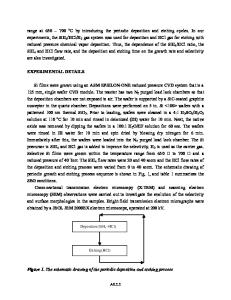Growth by Low Pressure Chemical Vapor Deposition of Silicon Quantum Dots on Insulator for Nanoelectronics Devices
- PDF / 2,331,657 Bytes
- 6 Pages / 417.6 x 639 pts Page_size
- 32 Downloads / 326 Views
temperature (570-610'C). The samples are investigated by Atomic Force Micoscopy, Scanning Electron Microscopy, High Resolution Transmission Electron Microscopy and Spectroscopic Ellipsometry. We confirm that the chemical nature of the surface and precisely the presence of SiO bonds decreases the Si quantum dot density. By optimising the deposition parameters, a Si dot density of 1012 cmz can be obtained below 600'C on a pure Si 3 N 4 surface. The influence of hydrogen, provided by silane decomposition, on the Si nucleation mechanism will be discussed. INTRODUCTION In the last few years, a lot of work has been devoted to the growth of quantum dots for nanoelectronics. Room temperature operation of single electron devices requires dots of nanometer size (- 2-5 nm), as predicted from the quantification and Coulomb charging energies. Nakagawa et al. [1] have recently succeeded in producing Si dots a few nanometers in diameter on SiO 2 with a density of 3x10 11 cm- 2. Claassen et. al. have evaluated the influence of the substrate on the CVD silicon nucleation and have shown that the saturation density of silicon
nuclei is always larger for Si 3N4 substrates than for Si0 2 substrates [2]. A detailed study has been done for temperatures over 700'C. An extrapolation at 600'C provides a silicon cluster density of about 108 cm-2 for SiO 2 and 101 cm-2 for Si 3 N 4 surfaces. More recently, it was reported that Si nanocrystallites can be spontaneously grown on SiO 2 or Si3N 4 by controlling the early stages of Si film growth by LPCVD, and devices operating at room temperature were realised [1, 3-5]. We propose in this paper a detailed study of the influence of the deposition parameters on the formation of Si quantum dots using LPCVD on Si3N4 and SiOxNy substrates for which no precise study has ever been published ; we compare these results with those obtained on SiO 2 substrates. EXPERIMENT The substrates are prepared in special furnaces by LPCVD deposition of standard 28 nm thick silicon nitride films Si 3 N 4 or by the thermal growth of 2 nm silicon oxide layers SiC 2 on Si(100) substrates. They are then exposed to the air, where parasitic oxidation of the Si 3 N 4 surface can occur, and transferred to the deposition furnace. For clarity, Si 3N4 substrates with parasitic oxidation are simply called Si 3N 4 substrates, whereas the ones for which the oxidation has been minimized as much as possible are called pure Si3N4 substrates. Deposition was carried out by the thermal decomposition of pure silane in the 570-610'C temperature range. The gas 37 Mat. Res. Soc. Symp. Proc. Vol. 571 ©2000 Materials Research Society
pressure was adjusted between 0.12 Torr and 0.2 Torr. Atomic Force Microscopy (AFM), Scanning Electron Microscopy (SEM) and High Resolution Transmission Electron Microscopy (HRTEM) were used to structurally characterize the Si nanocrystallites. We have also used Spectroscopic Ellipsometry (SE) to measure the amount of deposited silicon. RESULTS Figure 1 shows AFM pictures of Si nanocrystallites deposited on Si0 2
Data Loading...





